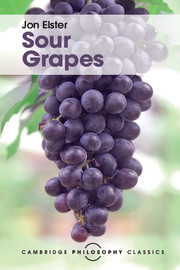Summary
On a familiar picture, you act rationally when you act to satisfy your desires. But sometimes the action and the desire interfere with each other in ways that make such a picture unstable. Presenting such problem cases is what Sour Grapes is about.
One problem arises when the desired end is something that cannot be aimed at without defeating that end. Stendhal wanted to be natural and the Dadaists wanted to be spontaneous, but one can't succeed in either by trying. Here the problem is conceptual. In other cases it is causal. We might have been the kind of creatures who could fall asleep by trying to do so, but for most of us, certainly for most insomniacs, trying makes things worse. Other cases live in some difficult in-between zone. Can one try to relax? Can one try to be modest?
Our problem is illustrated, though slightly inaccurately, by the title case. Desperately hungry, but unable to reach the grapes that hang above him, the fox declares them sour. They are not sour, so the fox is making a mistake. But he might instead have simply ceased to desire them, or, better still, have formed the positive desire not to eat them. Then he would be making no mistake, but his desire would be satisfied. We would have what Elster calls, in what has become the standard term, an adaptive preference: a desire that has adapted to what is available.
How should we think of such desires? If all that matters is satisfying one's desires, then changing the desire so that it fits the world should be just as good as changing the world so that it fits the desire. Perhaps sometimes it is. Stoic or Buddhist strategies that involve a meta-desire to have desires that fit the world seem to involve perfectly rational character planning. But the fox is no Buddhist. He simply has a blind causal mechanism – a drive, as Elster terms it, something that works ‘behind his back’ – that pulls his desires into accord with the world.
- Type
- Chapter
- Information
- Sour GrapesStudies in the Subversion of Rationality, pp. vii - viiiPublisher: Cambridge University PressPrint publication year: 2016

